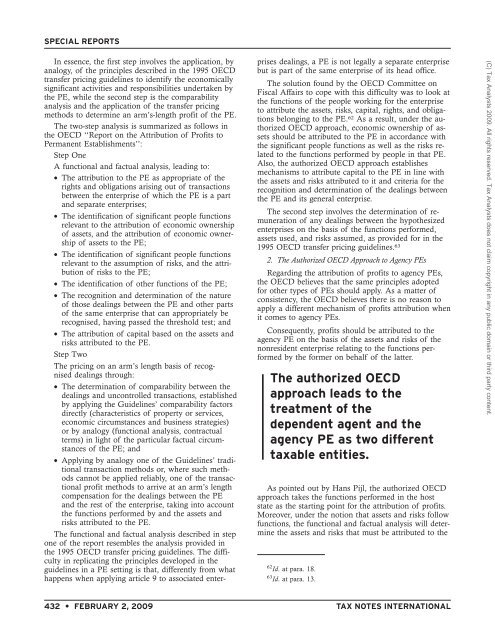tax notes international - Tuck School of Business - Dartmouth College
tax notes international - Tuck School of Business - Dartmouth College
tax notes international - Tuck School of Business - Dartmouth College
Create successful ePaper yourself
Turn your PDF publications into a flip-book with our unique Google optimized e-Paper software.
SPECIAL REPORTS<br />
In essence, the first step involves the application, by<br />
analogy, <strong>of</strong> the principles described in the 1995 OECD<br />
transfer pricing guidelines to identify the economically<br />
significant activities and responsibilities undertaken by<br />
the PE, while the second step is the comparability<br />
analysis and the application <strong>of</strong> the transfer pricing<br />
methods to determine an arm’s-length pr<strong>of</strong>it <strong>of</strong> the PE.<br />
The two-step analysis is summarized as follows in<br />
the OECD ‘‘Report on the Attribution <strong>of</strong> Pr<strong>of</strong>its to<br />
Permanent Establishments’’:<br />
Step One<br />
A functional and factual analysis, leading to:<br />
• The attribution to the PE as appropriate <strong>of</strong> the<br />
rights and obligations arising out <strong>of</strong> transactions<br />
between the enterprise <strong>of</strong> which the PE is a part<br />
and separate enterprises;<br />
• The identification <strong>of</strong> significant people functions<br />
relevant to the attribution <strong>of</strong> economic ownership<br />
<strong>of</strong> assets, and the attribution <strong>of</strong> economic ownership<br />
<strong>of</strong> assets to the PE;<br />
• The identification <strong>of</strong> significant people functions<br />
relevant to the assumption <strong>of</strong> risks, and the attribution<br />
<strong>of</strong> risks to the PE;<br />
• The identification <strong>of</strong> other functions <strong>of</strong> the PE;<br />
• The recognition and determination <strong>of</strong> the nature<br />
<strong>of</strong> those dealings between the PE and other parts<br />
<strong>of</strong> the same enterprise that can appropriately be<br />
recognised, having passed the threshold test; and<br />
• The attribution <strong>of</strong> capital based on the assets and<br />
risks attributed to the PE.<br />
Step Two<br />
The pricing on an arm’s length basis <strong>of</strong> recognised<br />
dealings through:<br />
• The determination <strong>of</strong> comparability between the<br />
dealings and uncontrolled transactions, established<br />
by applying the Guidelines’ comparability factors<br />
directly (characteristics <strong>of</strong> property or services,<br />
economic circumstances and business strategies)<br />
or by analogy (functional analysis, contractual<br />
terms) in light <strong>of</strong> the particular factual circumstances<br />
<strong>of</strong> the PE; and<br />
• Applying by analogy one <strong>of</strong> the Guidelines’ traditional<br />
transaction methods or, where such methods<br />
cannot be applied reliably, one <strong>of</strong> the transactional<br />
pr<strong>of</strong>it methods to arrive at an arm’s length<br />
compensation for the dealings between the PE<br />
and the rest <strong>of</strong> the enterprise, taking into account<br />
the functions performed by and the assets and<br />
risks attributed to the PE.<br />
The functional and factual analysis described in step<br />
one <strong>of</strong> the report resembles the analysis provided in<br />
the 1995 OECD transfer pricing guidelines. The difficulty<br />
in replicating the principles developed in the<br />
guidelines in a PE setting is that, differently from what<br />
happens when applying article 9 to associated enter-<br />
prises dealings, a PE is not legally a separate enterprise<br />
but is part <strong>of</strong> the same enterprise <strong>of</strong> its head <strong>of</strong>fice.<br />
The solution found by the OECD Committee on<br />
Fiscal Affairs to cope with this difficulty was to look at<br />
the functions <strong>of</strong> the people working for the enterprise<br />
to attribute the assets, risks, capital, rights, and obligations<br />
belonging to the PE. 62 As a result, under the authorized<br />
OECD approach, economic ownership <strong>of</strong> assets<br />
should be attributed to the PE in accordance with<br />
the significant people functions as well as the risks related<br />
to the functions performed by people in that PE.<br />
Also, the authorized OECD approach establishes<br />
mechanisms to attribute capital to the PE in line with<br />
the assets and risks attributed to it and criteria for the<br />
recognition and determination <strong>of</strong> the dealings between<br />
the PE and its general enterprise.<br />
The second step involves the determination <strong>of</strong> remuneration<br />
<strong>of</strong> any dealings between the hypothesized<br />
enterprises on the basis <strong>of</strong> the functions performed,<br />
assets used, and risks assumed, as provided for in the<br />
1995 OECD transfer pricing guidelines. 63<br />
2. The Authorized OECD Approach to Agency PEs<br />
Regarding the attribution <strong>of</strong> pr<strong>of</strong>its to agency PEs,<br />
the OECD believes that the same principles adopted<br />
for other types <strong>of</strong> PEs should apply. As a matter <strong>of</strong><br />
consistency, the OECD believes there is no reason to<br />
apply a different mechanism <strong>of</strong> pr<strong>of</strong>its attribution when<br />
it comes to agency PEs.<br />
Consequently, pr<strong>of</strong>its should be attributed to the<br />
agency PE on the basis <strong>of</strong> the assets and risks <strong>of</strong> the<br />
nonresident enterprise relating to the functions performed<br />
by the former on behalf <strong>of</strong> the latter.<br />
The authorized OECD<br />
approach leads to the<br />
treatment <strong>of</strong> the<br />
dependent agent and the<br />
agency PE as two different<br />
<strong>tax</strong>able entities.<br />
As pointed out by Hans Pijl, the authorized OECD<br />
approach takes the functions performed in the host<br />
state as the starting point for the attribution <strong>of</strong> pr<strong>of</strong>its.<br />
Moreover, under the notion that assets and risks follow<br />
functions, the functional and factual analysis will determine<br />
the assets and risks that must be attributed to the<br />
62 Id. at para. 18.<br />
63 Id. at para. 13.<br />
432 • FEBRUARY 2, 2009 TAX NOTES INTERNATIONAL<br />
(C) Tax Analysts 2009. All rights reserved. Tax Analysts does not claim copyright in any public domain or third party content.
















